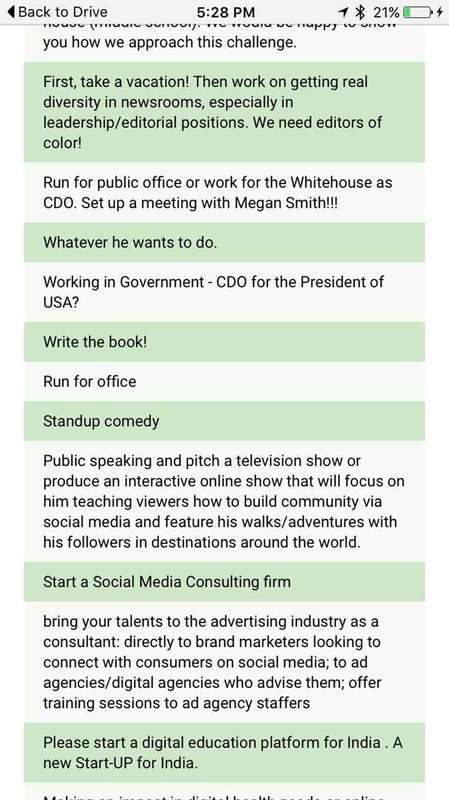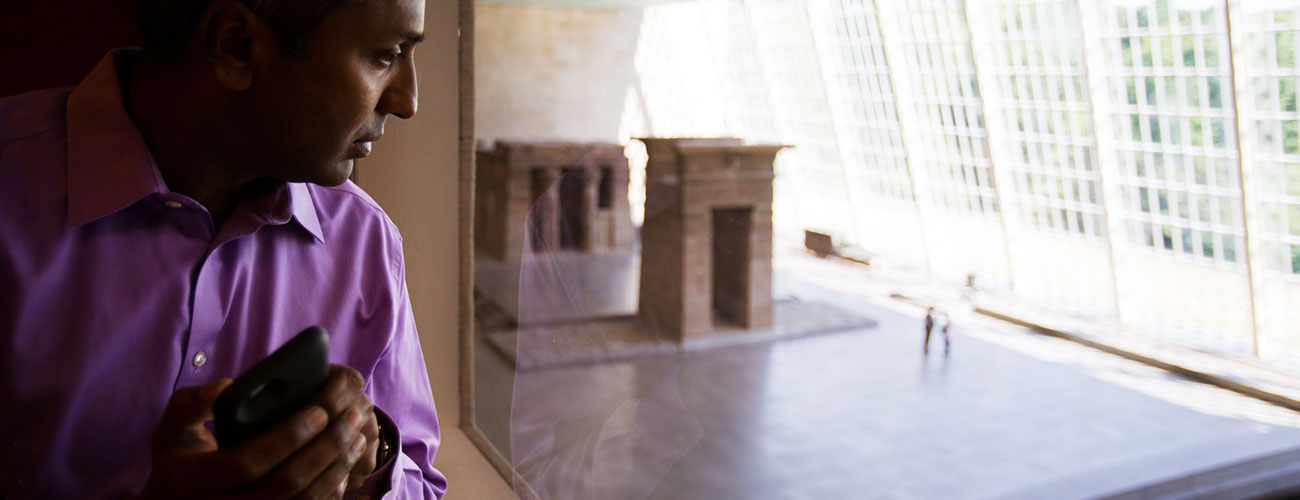The name Sreenath “Sree” Sreenivasan has become practically synonymous with social media. So naturally, when presented with what some might call a “career crisis”–his employer, the Metropolitan Museum of Art, decided last month to let him go in a cost-cutting move–Sreenivasan turned to the medium he knows best.
Sreenivasan wrote a very honest note about the news on Facebook and asked his 4,996 friends for suggestions on his next move. The response was overwhelming: 959 likes, 486 comments, 48 shares, and more than 1,100 responses to his online form to collect ideas for possible next steps. He plans to carefully review all the suggestions, which include trying his hand at standup comedy and running for public office, this weekend.

While at the Met, Sreenivasan experimented with social media, pioneering The Artist Project and initiating the Met’s use of Facebook Live and 360 videos. The Met’s following grew during his tenure to 1.7 million on Facebook, 1.5 million on Twitter, and 1.4 million on Instagram.
Sreenivasan, 45, talked with CJR about what he learned during his time at the Met and how he used his social media skills to cope with being fired, and shared some advice for keeping on top of advancing technology. The interview has been edited for length and clarity.
How did you fall into technology at such an early stage in the game and decide this was what you wanted to do?
When I came to Columbia University [as a graduate student] in the fall of ‘92, I took a business reporting class with Josh Mills. I loved business, the business of people rather than the business of money. Josh taught me how to report and think about the non-financial aspect. We were using LexisNexis, really the only digital work we were doing at the time. And over time I developed a real interest in trying to figure out how technology can help. A lot of it had to do with being a foreigner in America, and the importance of connecting with my grandparents in India by email.
When you left the Met, you posted about it on Facebook. Can you talk about what inspired that post and why you decided to be so open about the situation?
Any internal memo that anybody writes, someone’s going to forward it directly to Gawker or Poynter or one of those journalism websites. I always used to think about how anything you write is going to be public. It was a very emotional day: I had just told my team [the news], and then I came out and had to write this. And so I took the memo and I talked about it. It is very important to have a sense of your own narrative and your own story, and you want to tell your story instead of [leaving it to] anyone else.
I never lost a job before, but also to be fair, I’ve only had two full time proper jobs since I’ve come to America. One was [as a professor and dean at the Columbia Journalism School] and then this. I delayed telling my kids and my parents. My kids because the kids will worry “Oh my god, there’s not going to be any Christmas this year.” And my parents would be like “Oh my god, my son doesn’t have a job.” I have been teaching my students for years that you should take control of your own story and you should ask for help. Just saying you need a job isn’t enough anymore. Tell us what you can do and what you have done, because people want to help you.
When you first went to the Met, did it feel like you were leaving the journalism industry?
In some ways it was a big, big change for me to leave the university and to leave journalism. But the reason I went was that every company is now a media company, or has to become a media company. I was going to do all the things that I already was doing. It was a chance to actually do something around it rather than just talk about it. They were looking for someone, not from the art world, and I was super qualified. I was ready to think about how to put that kind of storytelling skill, which is the future of all business, and get to be a storyteller at the Met. At once, it is extremely simple and extremely complicated as a project. But I loved every minute of it, and thinking about how to connect to the world.
What did you learn about the journalism industry during your time there?
The themes that apply to media and journalism in general are the importance of connecting if you have a physical media product. The better you can do that, the more you can expand your audience. The other lesson is the importance of mobile: working with and creating content in mobile is going to be increasingly important. As an experiment, for the last year or so, I’ve been trying to do as much as I can on mobile. Since I walked out of the Met [on June 30], I have a counter that I’ve been using, and I’ve only spent 18 minutes on my desktop. Everything else has been on my mobile. I want to see how long I can carry that on.
Since I walked out of the Met [on June 30], I have a counter that I’ve been using, and I’ve only spent 18 minutes on my desktop. Everything else has been on my mobile.
Another lesson is the importance of visuals. We know that obviously already, but I’m obsessed with what I call “thumb stoppers.” Thumb stopper, because people are scrolling on their thumbs all day long. So let’s create thumb stoppers with every piece of content you post on social. Let’s make sure we have an image, a graphic, a photograph, a map, a quote, a gif–something that will stop the thumb.
Do you know what’s next for you as you embark on the next part of your journey, or as you called it in your Facebook post, “Sree 3.0”?
I don’t know yet. I want to first read the 1,100 suggestions from various people and try to see what ideas they have. I also am spending more time with my kids. I feel like I’m in the Tinder of speed dating/job hunting, where I’m swiping right like crazy. I’m taking every call and every meeting that I can. My days are packed from six in the morning until 10 at night. Last night, my last phone call started at 10:30pm. My advice to anyone who might think they will never be in this situation is that (a) it can happen to anybody, and (b) you should prepare for it before you need to. You may have heard me say it before, but building your community when you don’t need it is something I think about a lot.
I feel like I’m in the Tinder of speed dating/job hunting, where I’m swiping right like crazy.
Do you have other advice for journalists on why it’s important to keep up with technology and social media?
I used to do workshops on the new thing called email, and why you should use it. Journalists would say, “I love the fax; why should I need that?” The lesson would be: Please learn Twitter and learn LinkedIn, because it’s so important. Learn them when you don’t need them, so that they’re there when you need them. Otherwise you’ll come across as desperate. It is not just something frivolous that the kids are doing. I need to listen to myself. I have a Snapchat account, but I have not received or sent a snap yet. I tell people that I used to say I have no use for Twitter, and here I am. So one day maybe I’ll get on the Snapchat wagon, but I’m not there yet.
You make your own luck, so it’s never too late to get on board to learn digital and learn social. It gets better and gets smarter with the use of new technology, and it will help you.
Carlett Spike is a freelance writer and former CJR Delacorte Fellow. Follow her on Twitter @CarlettSpike.

